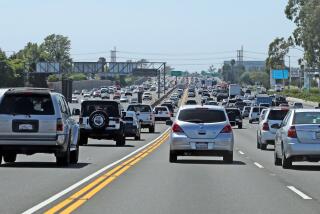New auto safety features focus on accident prevention
- Share via
At this year’s L.A. Auto Show, carmakers are highlighting safety features that focus on preventing accidents rather than merely surviving them.
Warning indicators for blind spots and rearview cameras have become common, but many manufacturers are taking the technologies a step further.
The additional features act on the safety warnings when a driver fails to do so, said Jeremy Anwyl, chief executive of online auto research firm Edmunds Inc.
“I think they are too easy to ignore,” he said of the warnings. “If your car has a whole series of these different lights flashing and buzzers, it is too much to process in a panic moment.”
Infiniti presented one solution with its Infiniti JX, unveiled last week at the auto show. The JX boasts the world’s first backup collision intervention technology. Like existing backup sensors, the system beeps if it detects potential obstacles while the vehicle is in reverse. But now, if the driver does not respond, the system automatically brakes to prevent a collision.
“We initiated this technology in the industry,” said Kyle Bazemore, senior manager of Infiniti product communications. He said Infiniti also pioneered other proactive safety systems.
“We were the first to have lane-departure prevention — if you’re drifting out of your lane, it’ll automatically nudge you back in,” he said. “Also blind-spot intervention — if you move with something in your blind spot it also nudges you back.”
The new Ford Explorer on display at the auto show also integrates lane-departure technology. In addition, the Explorer features inflatable seat belts — a first in the industry — designed to reduce chest and neck injuries. Other safety options include blind-spot warnings and an automatic parallel-parking system.
“In the industry, the technologies are all already there,” said Cadillac spokesman David Caldwell. “The difference is what you tell these systems to do.”
One way Cadillac’s new XTS adopted these technologies is with its virtual bumper feature.
“For example, in a dark, low-speed place, like a parking garage with columns and pillars,” Caldwell said, “if you’re about to hit something, behind you or in front of you, the virtual bumper will alert the driver and apply full braking up to 25 mph.”
The XTS also offers a collision mitigation braking system that, simply put, understands and interprets the pressure the driver applies to the brake. So if the system feels a panicked stomp, the electronic brakes will intervene and help avoid nearby objects detected by sensors placed around the car.
These sensors and cameras can also detect if cyclists or pedestrians are approaching from the side. The system alerts the driver of this side traffic by vibrating the seat cushion on the corresponding side.
The XTS also added an airbag between the driver and front passenger seat, giving the vehicle a total of 10 airbags.
“It’s about as many as you can add without turning it into a pillow,” Caldwell said.
The new Scion iQ, the world’s smallest four-seater, has the most airbags in the industry, according to a spokeswoman at the carmaker’s auto show exhibit. The iQ added a rear-window airbag, an industry first, totaling 11 for the compact car.
Airbags aside, Volvo spokesman James Hope summed up what safety means for future cars: “It’s the whole idea of intuitive technology.”
Four U.S. Volvo models currently offer an active pedestrian detection system. The vehicle automatically brakes if the driver does not react to pedestrians detected by the radar. The car fully brakes up to 25 mph.
“This kind of technology is hugely useful because it doesn’t require that you pay full attention,” Anwyl said. “We are right at the beginning of what I think is going to be a huge wave of these features and it’s really all based on advanced technologies. Computers, processors are all getting to the point now where they can handle a vast amount of information and turn that information around.”
“What’s coming in the near future for Volvo, we’re talking 2014, is animal detection,” Hope said. “In Sweden, for example, there’s a big problem with elk and moose. The full weight of this animal coming through the windshield can kill occupants.”
What else is next? Anwyl said there eventually would be technology that enables cars to adapt to surrounding vehicles and prevent potential collisions.
“Cars will be able to communicate so each car knows what to do,” he said. “The technology is here. It’s just a few years off.”
Volvo is among the automakers already thinking in that direction. It’s working on a concept it calls “platooning,” Hope said.
“You have the lead car, and the car behind it drives to the tune of the car ahead,” he said. “This increases efficiency and safety — cars can drive closer together safely.”
The Cadillac XTS already offers a speed-range adaptive cruise control, enabling drivers to set a following distance from the car in front of them. Caldwell said this was a useful bonus for Angelenos driving on crowded freeways in stop-and-go traffic.
“In the end, it’s about helping the driver see better,” he said. “We don’t want to take over the driver, but we do want to assist the driver.”
Times staff writer Angel Jennings contributed to this article.
More to Read
Inside the business of entertainment
The Wide Shot brings you news, analysis and insights on everything from streaming wars to production — and what it all means for the future.
You may occasionally receive promotional content from the Los Angeles Times.











